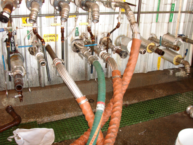Improving Hose Assembly Service Life in Chemical Blending Stations
By: Frank Caprio | On: June 17, 2020

The Chemical Processing Industry presents many challenges when specifying the best flexible hose for a given application. While it is critically important to provide a safe, reliable assembly that will resist high temperatures and corrosive conditions, certain applications where the hose is routinely moved around by the operators may necessitate special options or accessories to increase assembly service life. Let’s look at some ways to increase the safety, longevity, and value of these hoses.
 Base Chemicals vs. Specialty Chemicals
Base Chemicals vs. Specialty Chemicals
The specialty chemicals industry produces a wide variety of finished goods, many of which are proprietary formulations. Some of the largest specialty chemical segments include specialty polymers, industrial and household cleaners, various intermediate chemicals, and flavors and fragrances. These chemicals can also be classified by the industries in which they are used, including agriculture, oil & gas, construction, cosmetics, and food. Whereas base chemical manufacturing primarily focuses on making large quantities of “building-block” chemicals, the specialty chemical industry is as varied as the products themselves.
Specialty chemicals must be precisely measured in order to ensure product consistency. This blending operation may require a battery of hoses, each conveying the various ingredients to the mixing station. Even more hoses provide media used for cleaning, purging, and inerting operations. The hoses used in this area may be rubber, composite, or corrugated metal, and each hose type offers certain advantages along with certain limitations.
Handle with Care
Blending hoses are subjected to frequent (and sometimes rough) handling by the operators, which can increase the likelihood of damaging the hose. We have seen countless applications where the service life of blending station assemblies can be improved just by training the operators in proper hose handling, inspection, and storage practices. The operator must be vigilant to ensure hoses don’t become tangled, over-bent, twisted, or crushed. Often, wear-resistant covers are used on blending hoses to protect them from external damage. While these covers offer a degree of protection, most of them do not prevent the hose from being bent beyond its design. In fact, when these sleeves pull back from the hose ends, it should be brought to the customer’s attention in order to illustrate the need for a better way to protect these hose assemblies from damage.

Note how the protective covers have pulled back from the hose ends. A better solution is needed here.
Making changes to the piping system layout can improve assembly performance as well. Note how the upper bank of connections in the photo are oriented at a 45-degree angle downward. This allows hoses to gently slope down to the ground when connected to these ports. However, the lower connections are horizontally oriented, which can cause hoses to sag and over-bend. In these installations, a more robust cover may be needed to prevent over-bending the assembly.
Corrugated metal hose assemblies with interlocking metal armor guard are ideally suited for these mixing applications for many reasons. In addition to being fire-resistant and highly flexible, they do not experience permeation issues the way non-metallic hoses do– which is especially important for compressed gas lines in purging and inerting operations! Also, the end fitting configuration is more compact than other hose types which require barbed fittings, so the assembly is more easily positioned to facilitate connecting the assembly. The interlocked armor guard serves to protect the hose from external damage while also preventing the hose from being over-bent, which is a common mode of failure in chemical blending operations. Most other covers provide only limited protection from impact damage and do not act as a bend restrictor. Because Hose Master makes both the corrugated and interlocked hoses, we customize the size of the guard to make sure it fits snugly over the inner hose, providing great ease of handling and superior protection.
When inspecting hoses in these blending and mixing stations, look for signs of over-bending, external damage, twisted or kinked assemblies, or covers that have pulled back from the hose ends. Ask the customer about their hose inspection, testing, and replacement program, and make recommendations to improve hose assembly safety and service life. Working with us ensures there are no “mixed” messages when it comes to chemical blending!

